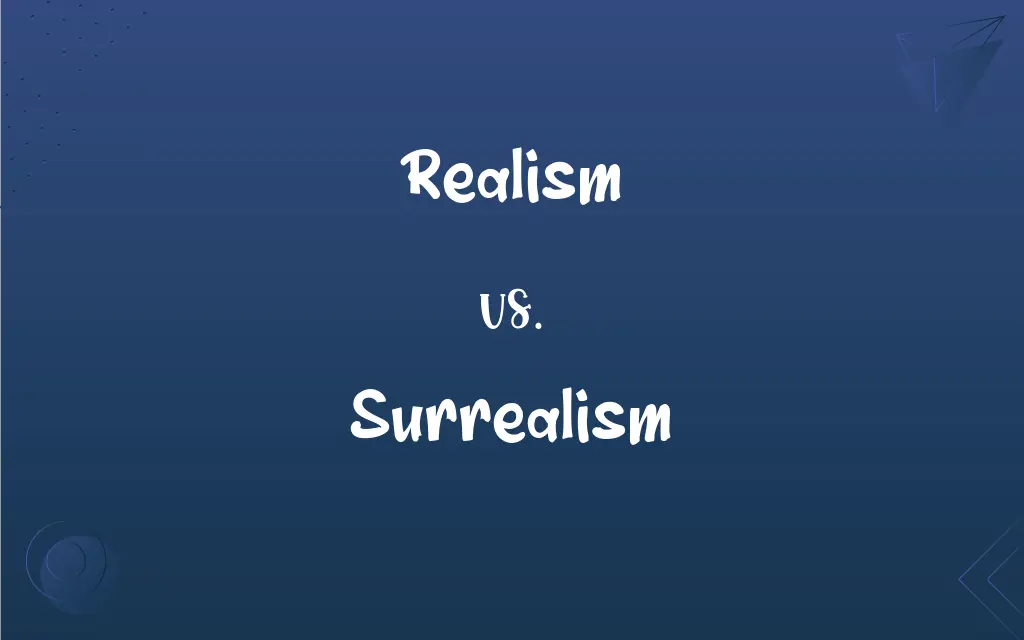Realism vs. Surrealism: What's the Difference?
Edited by Harlon Moss || By Janet White || Updated on October 6, 2023
Realism depicts life as it is; Surrealism combines dreams and reality.

Key Differences
Realism is an artistic and literary movement that strives to depict the world as it truly is, without embellishment or idealization. On the other hand, Surrealism is an artistic and literary movement that blends dreamlike images and bizarre juxtapositions, seeking to unlock the unconscious mind.
Realism tends to present a direct, objective view of the everyday world, capturing its mundanities and veracities. In contrast, Surrealism delves into a fantastical realm, merging the ordinary with the extraordinary, and often defying logic.
Artists and writers in the Realism movement observed and depicted life with a critical eye, aiming to represent it authentically. Surrealism, meanwhile, often drew from dream imagery and the irrational, emphasizing the mysterious and inexplicable aspects of human psyche.
In Realism, there's a strong emphasis on detail, clarity, and precision. The viewer can often relate directly to the content. With Surrealism, artworks or texts can evoke confusion, surprise, or deep introspection, as they play with unexpected combinations and illogical scenarios.
Realism can be seen as a reflection of the tangible, material world around us. Surrealism, however, can be considered an exploration of the intangible, immaterial realm of dreams, subconscious thoughts, and emotions.
ADVERTISEMENT
Comparison Chart
Origin of Movement
Mid-19th century, primarily in France
Early 20th century, Paris
Inspiration
Everyday life, society, and its struggles
Dreams, the subconscious, and the irrational
Technique
Detailed, precise, and clear depiction
Dreamlike, illogical juxtapositions
Main Objective
Represent reality without embellishment
Unlock and portray the unconscious mind
Example Works
Paintings by Gustave Courbet
Paintings by Salvador Dalí
ADVERTISEMENT
Realism and Surrealism Definitions
Realism
An accurate, detailed depiction of nature or life.
The photographer's Realism captured the raw emotions of the subjects.
Surrealism
An art movement blending dreams with reality.
The artwork's bizarre imagery is a classic representation of Surrealism.
Realism
A philosophical viewpoint that entities exist independently of perception.
The scientist argued for Realism in the debate, insisting that atoms existed even if we couldn't see them.
Surrealism
A style that juxtaposes unexpected elements.
The film blended comedy and horror in a blend of Surrealism.
Realism
A focus on portraying reality without idealization.
The painting shows the hardships of everyday life with stark Realism.
Surrealism
Artistic expression of the unconscious mind.
His paintings tap into the depths of Surrealism, revealing a dreamlike landscape.
Realism
An inclination toward literal truth and pragmatism.
Surrealism
Emphasis on the mysterious and dreamlike.
The play transported the audience to a world of Surrealism, where time flowed backward.
Realism
The representation in art or literature of objects, actions, or social conditions as they actually are, without idealization or presentation in abstract form.
Surrealism
Literature and art that defy conventional logic.
The poet's use of language was a deep dive into Surrealism, merging the nonsensical with the profound.
Realism
The scholastic doctrine, opposed to nominalism, that universals exist independently of their being thought.
Surrealism
A literary and artistic movement of the 1900s that attempts to express the workings of the subconscious and is characterized by fantastic imagery and incongruous juxtaposition of subject matter.
Realism
The modern philosophical doctrine, opposed to idealism, that objects exist independently of their being perceived.
Surrealism
Literature or art produced in this style.
Realism
A concern for fact or reality and rejection of the impractical and visionary.
Surrealism
An artistic movement and an aesthetic philosophy that aims for the liberation of the mind by emphasizing the critical and imaginative powers of the subconscious.
Realism
An artistic representation of reality as it is.
Surrealism
A 20th century movement of artists and writers (developing out of Dadaism) who used fantastic images and incongruous juxtapositions in order to represent unconscious thoughts and dreams
Realism
(sciences) The viewpoint that an external reality exists independent of observation.
Realism
(philosophy) A doctrine that universals are real—they exist and are distinct from the particulars that instantiate them.
Realism
As opposed to nominalism, the doctrine that genera and species are real things or entities, existing independently of our conceptions. According to realism the Universal exists ante rem (Plato), or in re (Aristotle).
Realism
Fidelity to nature or to real life; representation without idealization, and making no appeal to the imagination; adherence to the actual fact.
Realism
The practise of assessing facts and the probabilities of the consequences of actions in an objective manner; avoidance of unrealistic or impractical beliefs or efforts. Contrasted to idealism, self-deception, overoptimism, overimaginativeness, or visionariness.
Realism
The attribute of accepting the facts of life and favoring practicality and literal truth
Realism
(philosophy) the philosophical doctrine that physical object continue to exist when not perceived
Realism
The state of being actual or real;
The reality of his situation slowly dawned on him
Realism
An artistic movement in 19th century France; artists and writers strove for detailed realistic and factual description
Realism
(philosophy) the philosophical doctrine that abstract concepts exist independent of their names
Realism
An art and literature movement that represents life as it is.
The novel's Realism was praised for its detailed depiction of the working class.
Realism
Truthful representation of the mundane.
The documentary was lauded for its Realism in showing the struggles of refugees.
FAQs
When did the Realism movement begin?
The Realism movement primarily began in the mid-19th century.
Who started the Surrealism movement?
Surrealism was initiated by André Breton in the early 20th century.
Why did artists turn to Realism?
Artists turned to Realism as a reaction against Romanticism, aiming to depict the truth and hardships of everyday life.
Can Realism be subjective?
While Realism aims for objective representation, artists' perspectives can introduce subtle subjectivity.
Which artists are synonymous with Realism?
Gustave Courbet and Jean-François Millet are among the artists synonymous with Realism.
How do Realism and Surrealism approach the concept of truth?
Realism seeks to represent the tangible truth of everyday life, while Surrealism explores deeper, often subconscious truths.
What is the primary focus of Realism in art?
Realism focuses on depicting subjects as they appear in real life, without embellishment.
Which writers or poets are associated with Surrealism?
André Breton, Paul Éluard, and Louis Aragon are key figures in Surrealist literature.
How did societal changes impact the emergence of Realism?
Industrialization, urbanization, and societal changes highlighted everyday struggles, influencing artists to adopt a Realist approach.
How does Surrealism differ from Realism?
Surrealism blends dreamlike elements with reality, often defying logic, while Realism depicts life as it is.
What are the key themes in Surrealism?
Key themes include dreams, the unconscious mind, and the irrational.
How has Surrealism influenced modern art?
Surrealism has paved the way for abstract art forms and has influenced various media, from film to advertising.
How has technology impacted the Realism movement?
The advent of photography in the 19th century both challenged and complemented Realism by offering another medium to capture reality.
Are there literary counterparts to these art movements?
Yes, both Realism and Surrealism have counterparts in literature, with works portraying real-life or dreamlike narratives respectively.
Can a work be both Realistic and Surrealistic?
While they have contrasting approaches, some works, especially in literature, can have Realistic narratives with Surrealistic elements.
What role did psychology play in the development of Surrealism?
The emerging study of psychology, especially the works of Freud, deeply influenced Surrealists' exploration of the subconscious.
Is Surrealism still prominent today?
While the formal movement has waned, its influence persists in contemporary art, film, and popular culture.
Are there sub-genres within these movements?
Yes, both movements have spawned various sub-genres or related movements, like Magical Realism which combines elements of both.
Why are dreamlike images predominant in Surrealism?
Surrealists believed in tapping into the unconscious mind, and dreams offered a direct gateway to this uncharted realm.
Does Realism have philosophical implications?
Yes, beyond art, Realism also refers to the philosophical belief that certain objective realities exist outside of human perception.
About Author
Written by
Janet WhiteJanet White has been an esteemed writer and blogger for Difference Wiki. Holding a Master's degree in Science and Medical Journalism from the prestigious Boston University, she has consistently demonstrated her expertise and passion for her field. When she's not immersed in her work, Janet relishes her time exercising, delving into a good book, and cherishing moments with friends and family.
Edited by
Harlon MossHarlon is a seasoned quality moderator and accomplished content writer for Difference Wiki. An alumnus of the prestigious University of California, he earned his degree in Computer Science. Leveraging his academic background, Harlon brings a meticulous and informed perspective to his work, ensuring content accuracy and excellence.































































